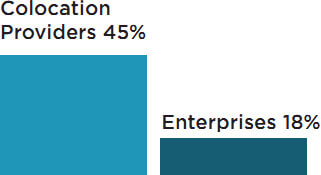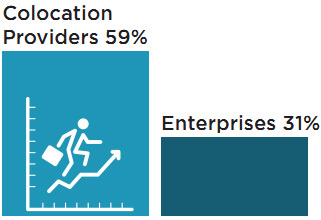
As businesses grow, the need for reliable and scalable data center space to colocate IT infrastructure also increases. Any data center or power downtime can have crippling effects on a business in the form of decreased productivity, customer churn and lost revenues. Successful businesses often outgrow their own in-house computer and telecom room quickly. They also require suitable environments to support software development, testing, QA and production applications. Furthermore, as businesses target enterprise customers, the need for industry compliance and security increases. It is important to perform a comprehensive analysis of the costs, risks, and opportunities of building an in-house data center versus buying colocation services.
Build VS. Buy Colocation
Uptime Institute’s 2015 Data Center Survey showed that colocation service providers are expanding more rapidly than enterprise data centers. The reason behind this is that many enterprise data center workloads are migrating out of private, single-tenant data centers. More and more enterprise IT leaders are finding it easier to outsource their workloads to colocation and cloud providers. The survey further pointed out that the colocation providers showed continued rapid growth—as shown in the percentage of new data center builds by colocation providers versus enterprises.
New Data Center Construction
Have you built a data center in the last 12 months?

Will your organization build a new data center in the next 12 months?

Building an in-house data center is expensive. In addition to tenant improvements to raw space, a company must consider the cost of bringing in more utility power and new carriers into their own data center. Also, installing new uninterruptible power systems (UPS), DC battery plants, diesel generators and HVAC systems to cool the servers, storage and networking equipment can be prohibitively expensive. These capital expense (CapEx) costs can add up quickly. Finally, hiring experienced data center personnel adds to the expense and takes resources away from a company’s core business.
In today’s highly competitive and technology-driven environment, businesses are increasingly looking to either build or outsource their physical data center environments.
Renting space from a colocation provider may offer significant savings versus building a data center in-house, because a colocation provider has the economies of scale of serving multiple customers. Using a colocation provider can also be more cost-effective when a business needs to scale over time.
Uptime Institute Tier Classifications
When considering building a data center, organizations typically build them to “tier classification” standards implemented by the Uptime Institute. The Uptime Institute is a leading 3rd party data center research, education, and consulting organization focused on data center performance and efficiency. The Uptime institute has been synonymous with certification and standards classifications within the data center industry.
Based on its research, the Uptime Institute has provided guidelines for Tier classifications and estimated the costs for building data centers. According to their research, the primary drivers of data center construction cost are the costs of power and cooling capacity to a data center.
The four Tier Classifications provide a simple means for identifying the most common designs for building data centers. The Institute’s tiered classification system addresses the needs of common benchmarking when discussing the abilities of data centers. The four tiers as classified by the Uptime Institute include the following:
The Uptime Institute’s research has also provided an estimation of the median costs of building facilities according to their tier structure. What transforms a raw space into a data center is the installation of utility power, redundant power systems and cooling. Data centers are often sized by the amount of protected electrical capacity of the facility measured in kilowatts (kW). The space required for power and mechanical needs grows incrementally based on the Tier level you decide upon. For example, Tier I and Tier II data centers can require a ratio of 1 to 1 support space, reducing actual allowed space for IT footprint. A Tier IV data center can require up to 3 to 1 of the space required to facilitate the IT footprint. Below are the Uptime Institute’s cost estimates for building a data center broken down by three components:
The "kW" Cost Component by desired level of functionality:
The "Computer Room" Component in all cases is $300/sq ft. of computer floor and this cost must be added to the kW cost shown above.
The "Empty Space" Component is added to the kW cost above at $190/sq. ft.
Cost Examples of Building a Data Center In-House
Based on the Uptime Institute benchmark costs, building data centers can be expensive. For example:
Mid-sized Enterprise Data Center (5,000 square feet)
Small Data Center (1,000 square feet)
Large “Telco Room” (500 square feet)
Build VS. Buy Colocation Comparisons
Below we will compare the costs of 1) building a single tenant data center and 2) renting space from a retail colocation provider. The cost assumptions are based on matching the material, operations, and maintenance programs of a TIER II colocation provider. We also include the ongoing operational costs over a 5-year period. These comparisons assume a build option with the load at 40% of capacity with room for growth, utility costs of $.08 per kWh and a 2.0 Power Usage Effectiveness (PUE), and an average 5 mile local loop/fiber cost of $150 per mile per strand vs. cross connects. Note that while many colocation operators with deep expertise in power efficiency and management can maintain a PUE of 1.3 to 1.5, building a single-tenant facility that is relatively small will result in a higher PUE. We have chosen to be extremely conservative in using a PUE assumption of 2.0.
Example A: 3 Cabinets @3kW Per Cab = 9 kW Load @30 kW Total Power Capacity
Costs to Build Data Center In-House
| Architectural, Engineering, and Permitting | |||
|---|---|---|---|
| Description | Material | Labor | Total |
| Engineering | $ | $14,625.00 | $14,625.00 |
| Permits, Prep, and Demo | $ | $5,435.50 | $5,435.50 |
| Power Construction | ||||
|---|---|---|---|---|
| Description | Material | Labor | Total | |
| Utility Improvements | $5,427.60 | $2,355.39 | $7,782.99 | |
| Electrical Panels Switch Gear | $29,250.00 | $13,325.00 | $42,575.00 | |
| Transfer Switches | $21,125.00 | $1,811.84 | $22,936.84 | |
| N + 1 UPS Systems | $58,500.00 | $13,000.00 | $71,500.00 | |
| TVSS System | $362.37 | $362.37 | $724.74 | |
| Generator & Enclosures | $46,800.00 | $9,421.55 | $56,221.55 | |
| Generator Conduit & Cabling | $1,449.47 | $1,449.47 | $2,898.94 | |
| Data Center Lighting | $1,521.94 | $1,304.52 | $2,826.46 | |
| Lighting Protection | $543.55 | $181.18 | $724.73 | |
| Room PDUs | $16,250.00 | $13,000.00 | $29,250.00 | |
| Environmental Controls | |||
|---|---|---|---|
| Description | Material | Labor | Total |
| Facility Management System | $2,174.20 | $362.37 | $2,536.57 |
| CCTV | $1,087.10 | $181.18 | $1,268.28 |
| Building Access System | $1,072.50 | $181.18 | $1,253.68 |
| Totals | ||||
|---|---|---|---|---|
| Description | Material | Labor | Total | |
| Total Build Estimate | $185,563.73 | $76,993.55 | $262,557.28 | |
| Total Colocation Cost of Ownership Build VS. Buy Comparison Over 5 Yrs. | ||||
|---|---|---|---|---|
| Description | Build In-House | Buy Colocation Services | ||
| Construction Costs | $263,000.00 | $0.00 | ||
| Floor Space 500 sq. ft. @ $12 sq. ft. Annually | $30,000.00 | $0.00 | ||
| Utility Electrical Cost @ 2.0 | $63,072.00 | $0.00 | ||
| Electrical Maintenance Costs | $23,855.00 | $0.00 | ||
| HVAC Maintenance Costs | $26,786.00 | $0.00 | ||
| All Other System Maintenance | $26,786.00 | $0.00 | ||
| Internet, Fiber, and Local Loop Charges | $180,000.00 | $30,000.00 | ||
| Colocation Svcs. 9kW @ $350/kW/mo + $10k NRC | $0.00 | $199,000.00 | ||
| Total | $613,499.00 | $229,000.00 | ||
63% Cost Savings of Buying Colocation VS. Building In-House
Example B: 8 Cabinets @ 3kW Per Cab = 24 kW Load @ 70 kW Total Power Capacity
| Architectural, Engineering, and Permitting | |||
|---|---|---|---|
| Description | Material | Labor | Total |
| Engineering | $ | $46,125.00 | $46,125.00 |
| Permits, Prep, and Demo | $ | $17,142.76 | $17,142.76 |
| Power Construction | ||||
|---|---|---|---|---|
| Description | Material | Labor | Total | |
| Utility Improvements | $17,142.76 | $7,428.53 | $24,571.29 | |
| Electrical Panels Switch Gear | $92,250.00 | $42,025.00 | $134,275.00 | |
| Transfer Switches | $66,625.00 | $42,025.00 | $108,650.00 | |
| N + 1 UPS Systems | $184,500.00 | $41,000.00 | $225,500.00 | |
| TVSS System | $1,142.85 | $1,142.85 | $2,285.70 | |
| Generator & Enclosures | $147,600.00 | $29,714.12 | $177,314.12 | |
| Generator Conduit & Cabling | $4,571.40 | $4,571.40 | $9,142.80 | |
| Data Center Lighting | $4,799.97 | $4,114.26 | $8,914.23 | |
| Lighting Protection | $1,714.28 | $571.43 | $2,285.71 | |
| Room PDUs | $51,250.00 | $41,000.00 | $92,250.00 | |
| Environmental Controls | |||
|---|---|---|---|
| Description | Material | Labor | Total |
| HVAC Assets | $63,550.00 | $45,714.03 | $109,264.03 |
| Raised Plenum Floor | $8,914.24 | $13,714.21 | $22,628.45 |
| Condensate Drains | $914.28 | $914.28 | $1,828.56 |
| Leak Detection | $2,742.84 | $548.57 | $3,291.41 |
| Fire Suppression | $19,372.50 | $6,857.10 | $26,229.60 |
| Environmental Controls | |||
|---|---|---|---|
| Description | Material | Labor | Total |
| Facility Management System | $6,857.10 | $1,142.85 | $7,999.95 |
| CCTV | $3,428.55 | $571.43 | $3,999.98 |
| Building Access System | $3,382.50 | $571.43 | $3,953.93 |
| Total Build Estimate | $680,758.27 | $346,894.30 | $1,027,652.52 |
| Total Colocation Cost of Ownership Build VS. Buy Comparison Over 5 Yrs. | ||||
|---|---|---|---|---|
| Description | Build In-House | Buy Tier II Colocation Services | ||
| Construction Costs | $1,027,652.52 | $0.00 | ||
| Floor Space 500 sq. ft. @ $12 sq. ft. Annually | $150,000.00 | $0.00 | ||
| Utility Electrical Cost @ 2.0 | $420,480.00 | $0.00 | ||
| Electrical Maintenance Costs | $54,337.00 | $0.00 | ||
| HVAC Maintenance Costs | $44,643.00 | $0.00 | ||
| All Other System Maintenance | $5,287.00 | $0.00 | ||
| Internet, Fiber, and Local Loop Charges | $180,000.00 | $30,000.00 | ||
| Colocation Svcs. 9kW @ $350/kW/mo + $10k NRC | $0.00 | $1,460,000.00 | ||
| Total | $1,882,399.52 | $1,490,000.00 | ||
21% Cost Savings of Buying Colocation VS. Building In-House
Other Important Considerations
Building your own in-house data center is not a walk in the park. You need to make an informed decision about the feasibility of building one versus colocating your workloads to a colocation provider. An in-depth analysis of the costs, risks, and opportunities corresponding to each option helps uncover hidden costs:
Conclusion
Building an in-house data center is an expensive undertaking especially when you consider the total cost of ownership over the next five years. Buying colocation services from a third-party service provider is more cost-effective than building your own. Based on estimates by the Uptime Institute, colocating can be 21%—63% more cost-effective than building an in-house Tier 2 data center.